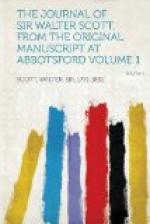October 31.—At breakfast visited by M. Gallois, an elderly Frenchman (always the most agreeable class), full of information, courteous and communicative. He had seen nearly, and remarked deeply, and spoke frankly, though with due caution. He went with us to the Museum, where I think the Hall of Sculpture continues to be a fine thing; that of Pictures but tolerable, when we reflect upon 1815. A number of great French daubs (comparatively), by David and Gerard, cover the walls once occupied by the Italian chefs-d’oeuvre. Fiat justitia, ruat coelum. We then visited Notre Dame and the Palace of Justice. The latter is accounted the oldest building in Paris, being the work of St. Louis. It is, however, in the interior, adapted to the taste of Louis XIV. We drove over the Pont Neuf, and visited the fine quays, which was all we could make out to-day, as I was afraid to fatigue Anne. When we returned home I found Count Pozzo di Borgo waiting for me, a personable man, inclined to be rather corpulent—handsome features, with all the Corsican fire in his eye. He was quite kind and communicative. Lord Granville had also called, and sent Mr. Jones [his secretary] to invite us to dinner to-morrow. In the evening at the Odeon, where we saw Ivanhoe. It was superbly got up, the Norman soldiers wearing pointed helmets and what resembled much hauberks of mail, which looked very well. The number of the attendants, and the skill with which they were moved and grouped on the stage, were well worthy of notice. It was an opera, and of course the story greatly mangled, and the dialogue in a great part nonsense. Yet it was strange to hear anything like the words which I (then in an agony of pain with spasms in my stomach) dictated to William Laidlaw at Abbotsford, now recited in a foreign tongue, and for the amusement of a strange people. I little thought to have survived the completing of this novel.[384]




